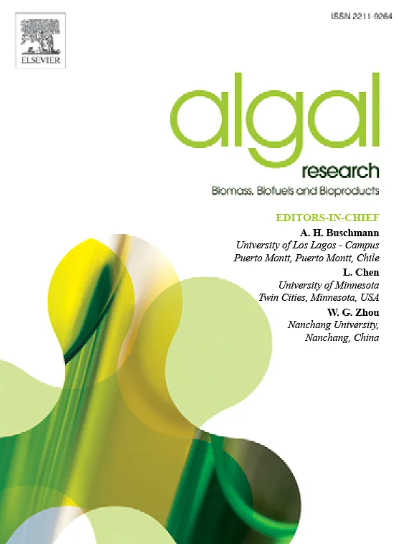磷形态与锌对三角褐指藻砷毒性及生物蓄积的共同影响
IF 4.5
2区 生物学
Q1 BIOTECHNOLOGY & APPLIED MICROBIOLOGY
Algal Research-Biomass Biofuels and Bioproducts
Pub Date : 2025-05-13
DOI:10.1016/j.algal.2025.104097
引用次数: 0
摘要
微藻利用共享砷酸盐(As(V))的转运蛋白有效地吸收磷酸盐(溶解无机磷,DIP)。此外,锌活化酶,碱性磷酸酶(AP),驱动溶解的有机磷(DOP)的同化,从而复杂地连接锌(Zn),磷(P)和砷(V)的动态。研究了两种不同磷形态(DOP和DIP)和Zn水平对三角褐指藻(Phaeodactylum tricornutum)砷(V)的毒性和生物蓄积的影响。结果表明,与DIP培养相比,DOP培养的三角草叶绿素a (Chl a)、植物胁迫检测光系统II最大光化学效率(Fv/fm)和细胞密度显著降低。然而,在DOP条件下,锌的补充缓解了三角草的发育。此外,结果还表明,DOP提高了三角弓形虫的As(V)毒性96 h EC50值,但Zn的添加减轻了这种影响。此外,在0.05 μmol·L−1 As(V)浓度下,与DOP培养相比,DOP+Zn培养的三角藻细胞内砷含量分别降低了35.79%和36.80%。然而,在DIP条件下,锌添加量对三角藻生长和胞内As的影响无显著差异。这些结果表明,DOP增强了微藻中As的毒性,而Zn可以显著减弱DOP下微藻中As的毒性和生物蓄积,从而影响海洋生态系统中As的循环。本文章由计算机程序翻译,如有差异,请以英文原文为准。

The combined effect of phosphorus forms and zinc on arsenic toxicity and bioaccumulation in Phaeodactylum tricornutum
Microalgae employ transporter proteins that are shared arsenate (As(V)) to efficiently uptake phosphate (dissolved inorganic phosphorus, DIP). Additionally, zinc-activated enzymes, alkaline phosphatase (AP), drive the dissolved organic phosphorus (DOP) assimilation, thereby intricately linking the dynamics of zinc (Zn), phosphorus (P), and As(V). This study investigated the effects of two distinct P forms (DOP and DIP) and Zn levels on the toxicity and bioaccumulation of As(V) in Phaeodactylum tricornutum. The results showed that P. tricornutum showed a marked decrease in chlorophyll a (Chl a), maximal photochemical efficiency of Photosystem II (Fv/fm) parameter for plant stress detection, and cell density in DOP cultures compared with DIP cultures. However, the supplementation of Zn alleviated the development of P. tricornutum in DOP conditions. Furthermore, the results also indicated that the 96-h EC50 values of As(V) toxicity in P. tricornutum was enhanced by DOP, but the addition of Zn alleviates this effect. Moreover, the intracellular As of P. tricornutum was reduced by 35.79 %, and 36.80 % in DOP+Zn culture compared to DOP culture at 0.05, and 0.1 μmol·L−1 As(V) exposures, respectively. However, there were no significant differences between Zn additions to the growth and intracellular As of P. tricornutum in DIP conditions. These results suggest that DOP enhances As toxicity in microalgae, but Zn can significantly attenuate the toxicity and bioaccumulation of As in microalgae under DOP, thereby impacting the cycling of As in marine ecosystems.
求助全文
通过发布文献求助,成功后即可免费获取论文全文。
去求助
来源期刊

Algal Research-Biomass Biofuels and Bioproducts
BIOTECHNOLOGY & APPLIED MICROBIOLOGY-
CiteScore
9.40
自引率
7.80%
发文量
332
期刊介绍:
Algal Research is an international phycology journal covering all areas of emerging technologies in algae biology, biomass production, cultivation, harvesting, extraction, bioproducts, biorefinery, engineering, and econometrics. Algae is defined to include cyanobacteria, microalgae, and protists and symbionts of interest in biotechnology. The journal publishes original research and reviews for the following scope: algal biology, including but not exclusive to: phylogeny, biodiversity, molecular traits, metabolic regulation, and genetic engineering, algal cultivation, e.g. phototrophic systems, heterotrophic systems, and mixotrophic systems, algal harvesting and extraction systems, biotechnology to convert algal biomass and components into biofuels and bioproducts, e.g., nutraceuticals, pharmaceuticals, animal feed, plastics, etc. algal products and their economic assessment
 求助内容:
求助内容: 应助结果提醒方式:
应助结果提醒方式:


